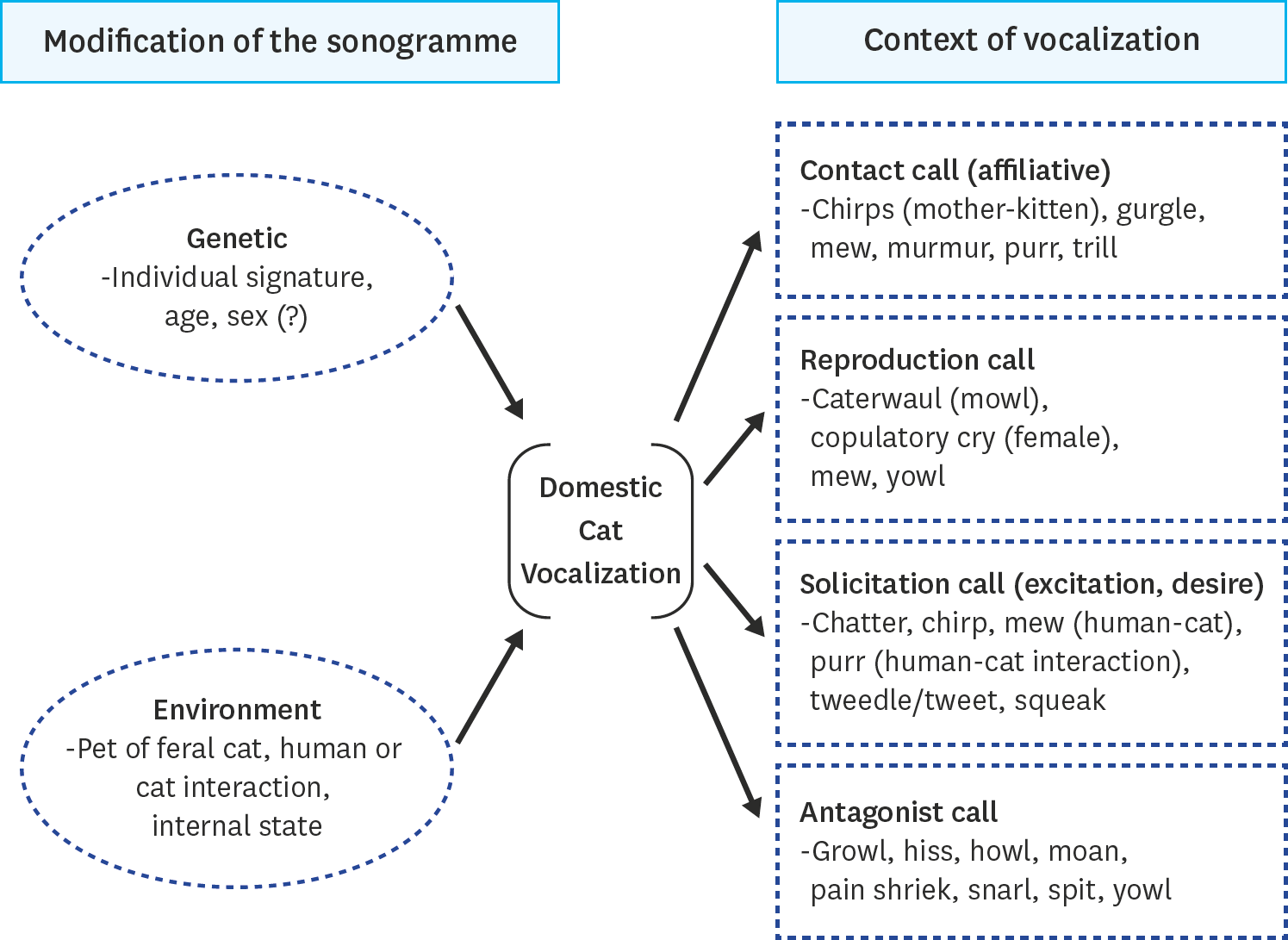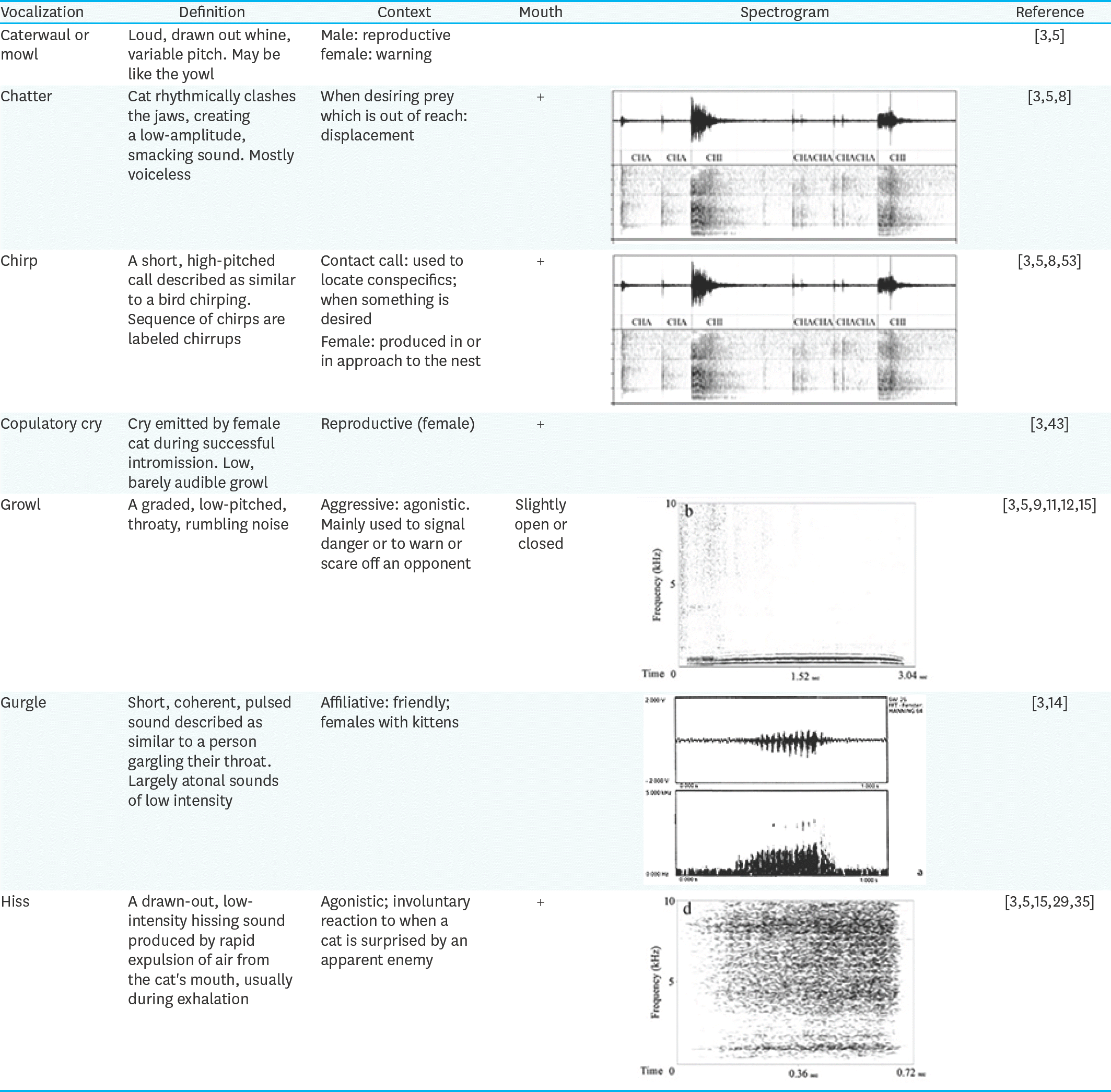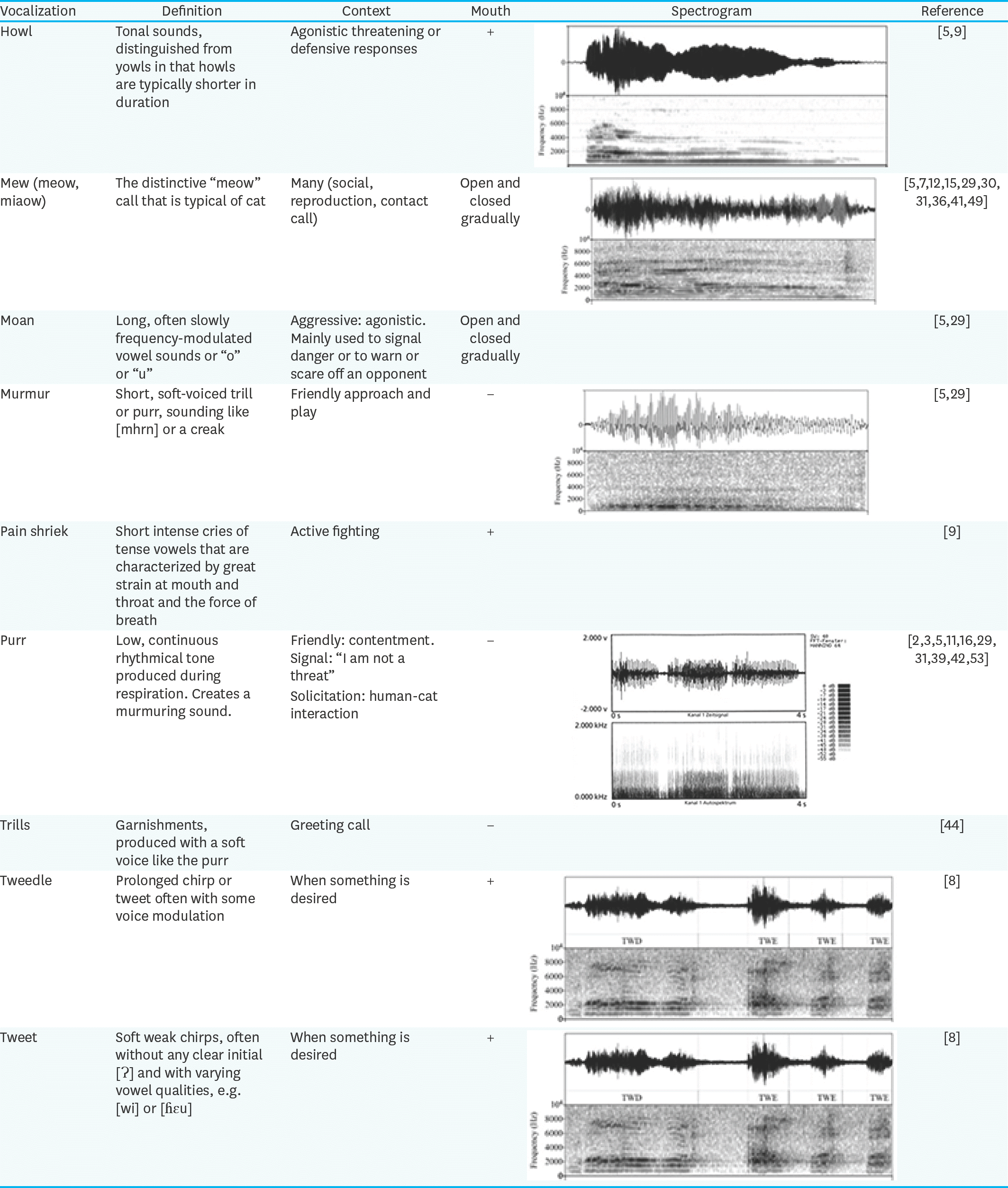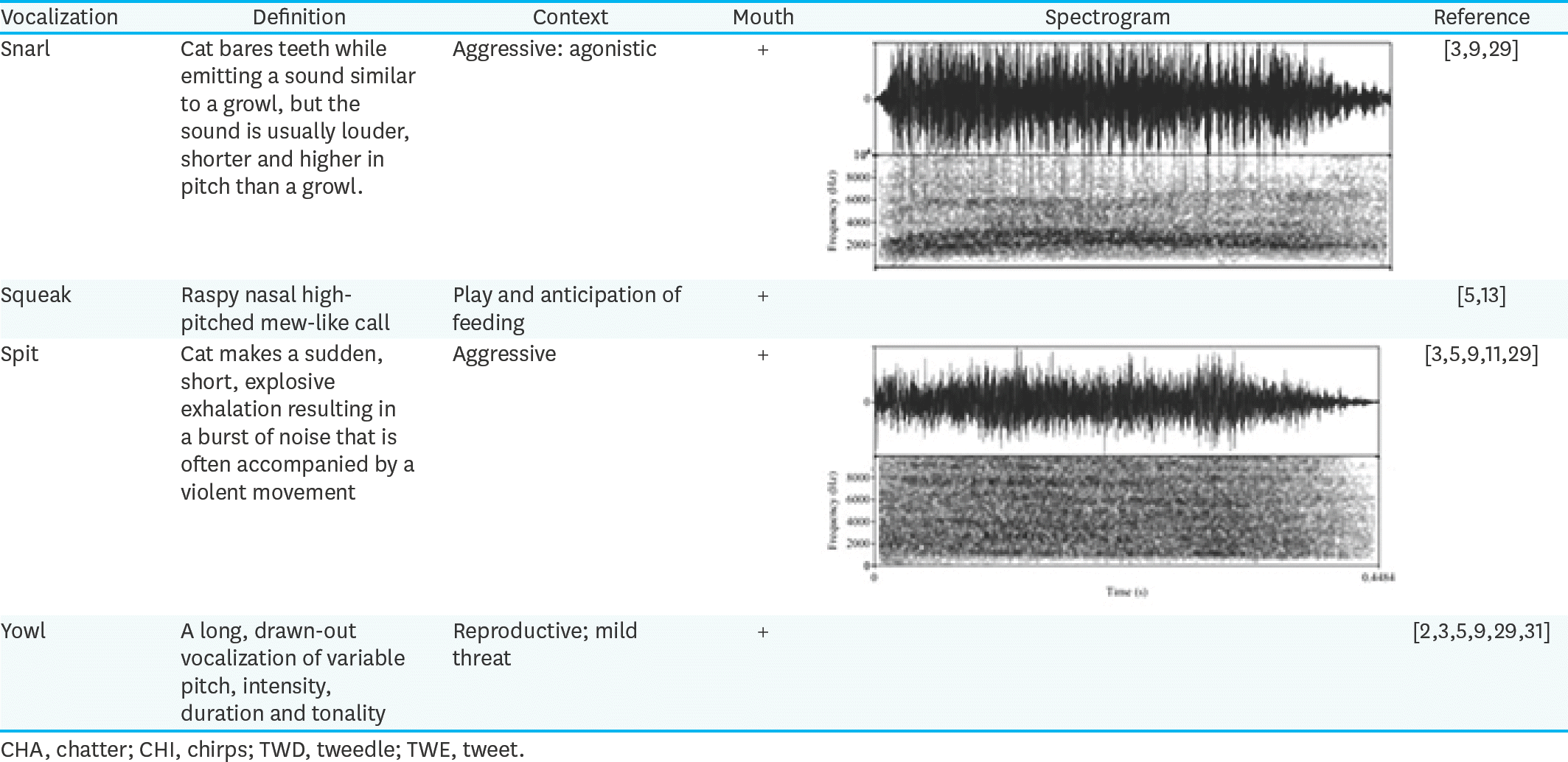Abstract
Cat vocalizes to communicate with another and express their internal states. The vocal repertoire of the cat is wide and up to 21 different vocalizations have been described in the literatures. But it is more than probable that the repertoire contains more types of vocalizations. An ethogram was created in this paper describing the actual known vocalisations of the domestic cat based on an auditory classification. However, the audiogram allows also a visual classification which can increase the accuracy of vocalization differentiation. The classification can be risky as it is sometimes unclear if different types of vocalizations are produced in different environments or if a unique type of vocalization is used with variation in the acoustic parameters. As an example, isolation calls produced by kittens differ depending on the context. The environment has an important impact on the vocal behaviour and thus feral cats and pet cats vocalize differently. Pet cats are thus able to create an efficient communication with humans thanks to the flexibility of vocalisation behaviours. This review allowed us to create a simple model of the cat vocal repertory.
Go to : 
References
1. Driscoll CA, Clutton-Brock J, Kitchener AC, O'Brien SJ. The taming of the cat. Genetic and archaeological findings hint that wildcats became housecats earlier–and in a different place–than previously thought. Sci Am. 2009; 300:68–75.
2. Kiley-Worthington M. Animal language? Vocal communication of some ungulates, canids and felids. Acta Zool Fenn. 1984; 171:8.
3. Stanton LA, Sullivan MS, Fazio JM. A standardized ethogram for the Felidae: a tool for behavioral researchers. Appl Anim Behav Sci. 2015; 173:3–16.

4. Bradshaw JW. The Behaviour of the Domestic Cat. CAB International;Wallingford: 1992.
5. Houpt KA. Domestic Animal Behavior for Veterinarians and Animal Scientists. Wiley-Blackwell;Ames: 2018.
6. Turner DC. A review of over three decades of research on cat-human and human-cat interactions and relationships. Behav Processes. 2017; 141:297–304.

7. Scheumann M, Roser AE, Konerding W, Bleich E, Hedrich HJ, Zimmermann E. Vocal correlates of sender-identity and arousal in the isolation calls of domestic kitten (Felis silvestris catus). Front Zool. 2012; 9:36.

8. Schötz S. A phonetic pilot study of chirp, chatter, tweet and tweedle in three domestic cats. In: Proceedings of Fonetik 2013;June 12–13. 2013. Linköping, Sweden.
9. Schötz S. Agonistic vocalisations in domestic cats: a case study. Svensson Lundmark M, Ambrazaitis G, Weijer JVD, editors. (eds.).Working Papers. pp.p. 85–90. Lund University;Linköping: 2015.
10. Bánszegi O, Szenczi P, Urrutia A, Hudson R. Conflict or consensus? Synchronous change in mother– young vocal communication across weaning in the cat. Anim Behav. 2017; 130:233–240.

11. Peters G. Vocal communication in cats. Seidensticker J, Lumpkin S, editors. (eds.).Great Cats—Majestic Creatures of the Wild. pp.p. 76–77. Rodale Press;Emmaus: 1991.
13. Romand R, Ehret G. Development of sound production in normal, isolated, and deafened kittens during the first postnatal months. Dev Psychobiol. 1984; 17:629–649.

14. Peters G, Tonkin-Leyhausen BA. Evolution of acoustic communication signals of mammals: friendly close-range vocalizations in Felidae (Carnivora). J Mamm Evol. 1999; 6:129–159.
15. Yeon SC, Kim YK, Park SJ, Lee SS, Lee SY, Suh EH, Houpt KA, Chang HH, Lee HC, Yang BG, Lee HJ. Differences between vocalization evoked by social stimuli in feral cats and house cats. Behav Processes. 2011; 87:183–189.

16. Eklund R, Peters G, Duthie ED. An acoustic analysis of purring in the cheetah (Acinonyx jubatus) and in the domestic cat (Felis catus). In: Proceedings of Fonetik 2010;June 2–4. 2010. Lund, Sweden.
17. Heffner HE, Heffner RS. Auditory perception. Phillips C, Piggins D, editors. (eds.).Farm Animals and the Environment. pp.p. 159–184. CAB International;Wallingford: 2002.
18. Leyhausen P. Cat Behavior: the Predatory and Social Behavior of Domestic and Wild Cats. Garland Publishing;New York: 1979.
19. Zhao Z, Ma L, Wang Y, Qin L. A comparison of neural responses in the primary auditory cortex, amygdala, and medial prefrontal cortex of cats during auditory discrimination tasks. J Neurophysiol. 2019; 121:785–798.

20. Saito A, Shinozuka K, Ito Y, Hasegawa T. Domestic cats (Felis catus) discriminate their names from other words. Sci Rep. 2019; 9:5394.
21. Herbst CT. Biophysics of vocal production in mammals. Suthers RA, Tecumseh Fitch W, Fay RR, Popper AN, editors. (eds.).Vertebrate Sound Production and Acoustic Communication. pp.p. 159–189. Springer;Berlin: 2016.

22. Moelk M. Vocalizing in the house-cat; a phonetic and functional study. Am J Psychol. 1944; 57:184–205.

23. Macdonald DW, Yamaguchi N, Kerby G. Group-living in the domestic cat: its sociobiology and epidemiology. Turner DC, Bateson P, editors. (eds.).The Domestic Cat: the Biology of its Behaviour. 2nd ed.pp.p. 95–118. Cambridge University Press;Cambridge: 2000.
24. Brown KA, Buchwald JS, Johnson JR, Mikolich DJ. Vocalization in the cat and kitten. Dev Psychobiol. 1978; 11:559–570.

25. Urrutia A, Martínez-Byer S, Szenczi P, Hudson R, Bánszegi O. Stable individual differences in vocalisation and motor activity during acute stress in the domestic cat. Behav Processes. 2019; 165:58–65.

26. Schötz S, van de Weijer J, Eklund R. Melody matters: an acoustic study of domestic cat meows in six contexts and four mental states. In: Proceedings of VIHAR 2019;August 29–30. 2019. London, UK.

27. Nicastro N. Perceptual and acoustic evidence for species-level differences in meow vocalizations by domestic cats (Felis catus) and African wild cats (Felis silvestris lybica). J Comp Psychol. 2004; 118:287–296.

28. Schötz S, Eklund R. A comparative acoustic analysis of purring in four cats. In: Proceedings of Fonetik 2011;June 8–10. 2011. Stockholm, Sweden.
29. Schötz S. A phonetic pilot study of vocalisations in three cats. In: Proceedings of Fonetik 2012;May 30– June 1. 2012. Gothenburg, Sweden.
30. Peters G, Baum L, Peters MK, Tonkin-Leyhausen B. Spectral characteristics of intense mew calls in cat species of the genus Felis (Mammalia: Carnivora: Felidae). J Ethol. 2009; 27:221–237.
31. Nicastro N, Owren MJ. Classification of domestic cat (Felis catus) vocalizations by naive and experienced human listeners. J Comp Psychol. 2003; 117:44–52.

32. Feuerstein N, Terkel J. Interrelationships of dogs (Canis familiaris) and cats (Felis catus L.) living under the same roof. Appl Anim Behav Sci. 2008; 113:150–165.

33. Peters G. Das schnurren der katzen (Felidae). Saugetierkdl Mitt. 1981; 29:30–37.
34. Renate H. Krafft-Ebing's psychological understanding of sexual behaviour. Porter R, Teich M, editors. (eds.).Sexual Knowledge, Sexual Science: the History of Attitude to Sexuality. pp.p. 210–230. Cambridge University Press;Cambridge: 1994.
35. McKinley PE. Cluster analysis of the domestic cat's vocal repertoire [unpublished doctoral thesis]. [College Park]: University of Maryland;1982.
36. Bradshaw J, Cameron-Beaumont C. The signaling repertoire of the domestic cat and its undomesticated relatives. Turner DC, Bateson P, editors. (eds.).The Domestic Cat: the Biology of Its Behaviour. pp.p. 68–93. Cambridge University Press;Cambridge: 2000.
37. Farley GR, Barlow SM, Netsell R, Chmelka JV. Vocalizations in the cat: behavioral methodology and spectrographic analysis. Exp Brain Res. 1992; 89:333–340.

38. Brown SL. The social behaviour of neutered domestic cats (Felis catus) [doctoral thesis]. [Southampton]: University of Southampton;1993.
40. Bradshaw J, Casey RA, Brown SL. The Behaviour of the Domestic Cat. CAB International;Wallingford: 2012.
41. McComb K, Taylor AM, Wilson C, Charlton BD. The cry embedded within the purr. Curr Biol. 2009; 19:R507–R508.

42. Vitale Shreve KR, Udell MA. What's inside your cat's head? A review of cat (Felis silvestris catus) cognition research past, present and future. Anim Cogn. 2015; 18:1195–1206.

43. Mellen JD. A comparative analysis of scent-marking, social and reproductive behavior in 20 species of small cats (Felis). Am Zool. 1993; 33:151–166.

44. Crowell-Davis SL, Curtis TM, Knowles RJ. Social organization in the cat: a modern understanding. J Feline Med Surg. 2004; 6:19–28.

45. Hockett CF. Logical Considerations in the Study of Animal Communication. American Institute of Biological Sciences;Washington, D.C.: 1960.
46. Owens JL, Olsen M, Fontaine A, Kloth C, Kershenbaum A, Waller S. Visual classification of feral cat Felis silvestris catus vocalizations. Curr Zool. 2017; 63:331–339.

47. Trut LN. Early canid domestication: the farm-fox experiment: foxes bred for tamability in a 40-year experiment exhibit remarkable transformations that suggest an interplay between behavioral genetics and development. Am Sci. 1999; 87:160–169.
48. Goodwin D, Bradshaw JW, Wickens SM. Paedomorphosis affects agonistic visual signals of domestic dogs. Anim Behav. 1997; 53:297–304.

49. Saito A, Shinozuka K. Vocal recognition of owners by domestic cats (Felis catus). Anim Cogn. 2013; 16:685–690.

50. Mertens C, Turner DC. Experimental analysis of human-cat interactions during first encounters. Anthrozoos. 1988; 2:83–97.

51. Ehret G, Romand R. Postnatal development of absolute auditory thresholds in kittens. J Comp Physiol Psychol. 1981; 95:304–311.

52. Villablanca JR, Olmstead CE. Neurological development of kittens. Dev Psychobiol. 1979; 12:101–127.

53. Szenczi P, Bánszegi O, Urrutia A, Faragó T, Hudson R. Mother-offspring recognition in the domestic cat: kittens recognize their own mother's call. Dev Psychobiol. 2016; 58:568–577.

54. Franklin S. Variation in vocalization in the domestic cat (Felis catus): the influence of human socialization, cat socialization and lineage [unpublished dissertation]. [Austin]: University of Texas;2002.
55. Haskins R. Effect of kitten vocalizations on maternal behavior. J Comp Physiol Psychol. 1977; 91:830–838.

56. Flowers A. Cats and Excessive Meowing [Internet]. Publisher;. 2017. [updated 2019;cited 2019 May 20]. Available from:. https://pets.webmd.com/cats/guide/cats-excessive-meowing.
Go to : 
 | Fig. 1.Overview of the domestic cat vocalization. Domestic cats can produce different types of vocalization in different communication contexts. However, these vocalizations can be altered by the cat's genetics, thus cats have individual vocalizations which especially matter in the mother-kitten interaction. The vocalizations can also be modulated by the environment of the cat, thus the same vocalization can be use in different contexts like the purr of the mew. |
Table 2.
Acoustic parameters of mew calls
Table 3.
Parameters of the ingressive and egressive phases of the purr vocalization




 PDF
PDF Citation
Citation Print
Print





 XML Download
XML Download